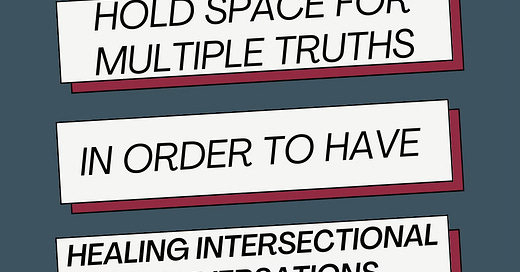As we embark on the journey of dismantling supremacy culture we will be in a constant state of UNlearning and RElearning new ways to communicate with ourselves and with others. Anti-oppression and pro-liberation work requires the recognition that this is trauma and grief work along with navigating through the complexities of human emotions, especially in the context of trauma and grief, and requires more than just good intentions.
It calls for a conscious, caring, and informed approach. That's why holding space for multiple truths is not just a method, but a journey towards understanding and healing. Whether you're a friend, a family member, or a professional in a supportive role, this guide is designed to equip you with the basics of facilitating conversations that respect and honor diverse experiences and perspectives.
Introduction: The Heart of Holding Space
Understanding the Foundation
Before diving into the 'how-to,' let's understand what it means to 'hold space.' At its core, holding space is the act of being physically, mentally, and emotionally present for someone, without judgment or an agenda. It's about creating a safe environment where all feelings, including grief and trauma, can surface and be acknowledged.
Section 1: The Principles of Holding Space
Laying the Groundwork for Trust and Safety
The first step in holding space for multiple truths is establishing trust. This means actively listening, showing empathy, and reinforcing a sense of safety. Respect the courage it takes for someone to share their healing journey, and remember that this process is not about you — it's about them and their experiences.
Section 2: Acknowledging Grief and Trauma
Recognizing the Weight of Pain
Grief and trauma can be incredibly isolating experiences. Acknowledge the pain without trying to fix it. Understand that healing is not linear and that what works for one may not work for another. Recognize the multiple truths that exist within someone's narrative, and honor each one without comparison or judgment.
Section 3: Navigating Multiple Truths
Balancing Varied Realities
Multiple truths often coexist in conversations about trauma and healing. Holding space means validating each truth, understanding that they are not mutually exclusive, and knowing that they can form a complex web of reality for the person you're supporting. It's important to allow individuals to express their truths without forcing reconciliation of different perspectives.
Section 4: The Healing Journey
Supporting Through Peaks and Valleys
The healing journey is unique for everyone. As you hold space, be prepared for a non-linear path that includes progress, setbacks, and moments of both hope and despair. Stay present and offer consistent support, ensuring the person feels seen and heard throughout their journey.
Section 5: Embracing Anti-Oppression in Healing Spaces
Cultivating an Inclusive Approach
Holding space effectively requires an anti-oppression lens. This means being aware of power dynamics, systemic barriers, and cultural differences that affect how individuals experience and process trauma. It's about making sure that the healing space is accessible, respectful, and responsive to the needs of all, particularly those from marginalized communities.
Section 6: Practical Tips for Holding Space
Tools for Everyday Support
Finally, let's talk about the practical aspects of holding space. This includes setting boundaries, managing your own emotions, and knowing when to offer resources or professional help. Learn the subtle art of asking permission to share thoughts or advice, and recognize when simply being present is the best support you can offer.
Incorporating these principles and practices into your interactions can make a world of difference for those navigating the turbulent waters of grief, trauma, and healing. As you continue to learn and grow in this role, remember that holding space is a privilege — one that allows you to witness and contribute to the incredible resilience of the human spirit.
Now, let’s unpack each section in detail.
Introduction: The Heart of Holding Space
Understanding the Foundation
When we talk about holding space, envision yourself as a container, vast and resilient, capable of containing the myriad of emotions and experiences that a person carries. This container does not leak or spill; it simply holds and respects the contents within it, allowing the person you're supporting to feel secure enough to unpack complex emotions related to grief, trauma, and their healing journey.
Section 1: The Principles of Holding Space
Laying the Groundwork for Trust and Safety
Creating a foundation of trust and safety is paramount. It starts with confidentiality, continues with non-judgmental listening, and is reinforced by your unwavering presence. This doesn't necessarily mean having the right answers or solutions, but rather, the right attitude—one that communicates, "You are not alone, and your truth matters."




